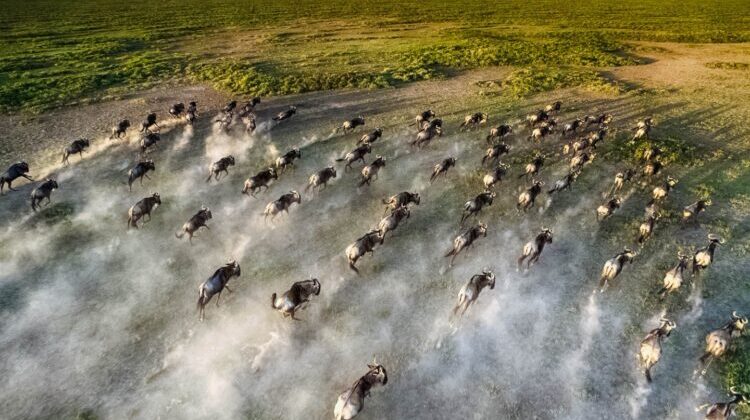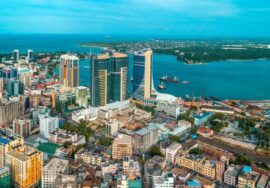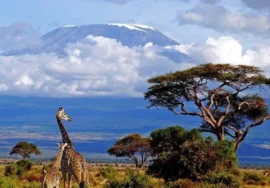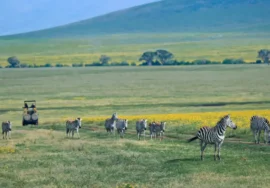
The Great Wildebeest Migration
The Great Wildebeest Migration. A truly remarkable occurrence is the Great Wildebeest Migration, which takes place every year and involves the migration of enormous herds of grazers over the northern regions of Tanzania and Kenya. Over two million wildebeest, zebras, and gazelles travel across the ecosystems of the Serengeti and Masai Mara in search of lush grass. This movement occurs in a predictable manner. Certainly, this is one of the most incredible natural wonders that the planet has to offer.
What You Need to Know About Great Migration Safari Vacations
It is possible to witness the Great Migration in Tanzania during the entire year. The migration takes place in a circular manner around the Serengeti National Park, that is why it is considered an ongoing event. We are going to break down the typical locations of wildebeest at various seasons of the year in the following paragraphs.
In the Masai Mara in Kenya, the Great Wildebeest Migration occurs only infrequently. The herds only ever travel there as an extension of their grazing meadows in the northernmost part of Tanzania if they are in need of fresh pastures. You will only be able to observe the migration in Kenya during the few months of the year when they are heading towards the border, and even then, the majority of the herds are still roaming around the northern sections of the Serengeti nonetheless…
An summary of the Annual Migration, including the most favorable dates to visit the Wildebeest in Africa
It is between the months of July through October that the wildebeest are in the plains of the northern Serengeti, and at this time you have the opportunity to witness as many as thousands of them crossing the Mara River. Due to the fact that the sight of wildebeest crossing the river is so breathtaking, many people believe this to be the most highly sought period to see the migration.
From December until March: The wildebeest are currently inhabiting the southern region of the Serengeti, more specifically in Ndutu, which is located within the Ngorongoro Conservation Area. This is the time of year when the wildebeest are giving birth to their young.
This is a fantastic time to witness the herds congregating on the majestic sweeping plains in the south, and it is also a true highlight of the wildebeest’s trek, along with the river crossings. Due to the fact that the large herds always travel south for calving season, February is the only month of the year in which it is practically certain that you will see each and every one of them together.
With regard to the remaining months of the year, the migration occurs “in between” sites throughout the months of November, April, May, and June. As a result, these months are slightly transitional times to see the herds. When the brief rains occur in November, the long rains occur in April and May, and as a result, the grass in the Serengeti is green during these months.
As a result, the wildebeest are more dispersed throughout these months than they are during the peak months of July through October and December through March. That way, you won’t have to worry about getting as many of those condensed large herds that people get excited about!
We make every effort to be as comprehensive as possible; nonetheless, something that is rather challenging to articulate in writing is a great deal simpler to explain over the phone. Therefore, if you would want a straightforward summary of the steps involved in the migration, please do not hesitate to give us a call.
There are a number of reasons why wildebeest migrate, including the Great Migration and the reasons why wildebeest migrate.
The primary reason why wildebeest go around the Serengeti and into the Masai Mara is to ensure that they are able to follow the accumulation of rain. Beginning in the Southern Serengeti region of Ndutu, they always start their cycle for their calving, which occurs between the months of December and March, and they continue their cycle wherever the grass is greener…
Despite the fact that we have a reasonable concept of where the wildebeest should be at any given time of the year, the actual location of the wildebeest is determined by the location of the rain. The wildebeest are notoriously unreliable because, despite the fact that they typically travel from the southern to the northern Serengeti and back again, they frequently make zigzag movements along the way. As a result, it is sometimes impossible to anticipate where the large herds will be at any given moment.
The kind of migration that wildebeests engage in; wildebeest in Africa
The migration that wildebeests undertake is an annual event that involves the movement of one and a half million wildebeest, together with hundreds of thousands of zebras and a great number of other species of antelope, in the direction of pastures that are greener. For the most lush grass, the animals go around the Serengeti in a circular direction, following the rains as they move through the area.
Over the course of five hundred kilometers, there are numerous predators, including lions, cheetahs, and crocodiles, that prey on the animals. This makes the journey extremely hazardous. The show is absolutely incredible to behold.
Even though we make every effort to provide as much information as possible, it is strongly recommended that you give us a call and have a conversation with an expert who can provide you with the most up-to-date information regarding the location of the wildebeest currently.
When does the Great Wildebeest Migration take place in Tanzania, and when does the wildebeest migration take place in the Masai Mara in Kenya?
Throughout the entirety of the year, the herds of wildebeest are consistently found in Tanzania. Kenya is home to a portion of the herds for a brief period of time during the year. From July till October, wildebeest are constantly crossing the Mara River in Tanzania between Kogatende and the Lamai wedge, which is the terrain that is located between the Mara River and the border with Kenya.
This time period is known as the “wildebeest migration.” In order to get from one side of the Masai Mara to the other (all of which are located in Kenya), the herds may occasionally cross the Mara river. Thus, Tanzania is the place where one is most likely to come across the well-known river crossings. We would always recommend staying yourself in the northern Serengeti rather than the Masai Mara in order to catch the wildebeest crossing the Mara River. Tanzania also has a significantly lower number of tourists on any given crossing.
An Introduction to the Great Migration in Africa, Including the Wildebeest Migration
It is a common misunderstanding that the river serves as a border between the two countries; however, as you can see, this is not the case! The wildebeest never cross the river from Tanzania into Kenya; rather, they only ever cross between Kogatende and the Lamai Wedge (Tanzania to Tanzania) or in Kenya from the Masai Mara into the Masai Mara (Kenya to Kenya). As a result, they never cross the river from Tanzania into Kenya.
Great Migration Safari Vacations: Where to Stay for Tanzania’s Great Migration Safari Vacations
It is highly recommended that you make reservations for one of the well-known mobile camps in the Serengeti in order to experience the thrill of going on safari in the middle of the Great Migration of wildebeest and zebra. The mobile camps are put up at predetermined sites throughout the year, and they frequently relocate between two and three times a year, depending on the location of the herds at that specific time of year.
The Serengeti Safari Camp, operated by Nomad Tanzania, and the Serengeti Under Canvas, operated by &Beyond, are two mobile camps that stand out from the rest of the competition due to their dedication to keeping pace with the herds. These are the two mobile operations that we regard to be truly mobile. They will be situated close to or among the herds at any time of the year, and they will move to more than two sites (which is the typical route taken by the majority of the other mobile camps).
In light of this, we may now discuss the mobile camps of Alex Walker’s Serian, Asilia’s Olakira, Ubuntu, and Kimondo. These camps move twice a year and provide exceptional mobile operations from July to November and from December to March. During the remaining months of the year, these wonderful camps will be closed.
The Serengeti features a number of permanent lodges that will provide you with all the creature comforts you require in addition to providing a wonderful site to watch the herds while you are on your Tanzania safari. If you find that being mobile is a bit too daring for you, then the Serengeti is the place for you. The following is a summary of the migration of the herds, as well as the permanent lodges that are the most suitable for staying at throughout each season.
An explanation of the Great Wildebeest Migration (also known as the Serengeti Wildebeest Migration) on a monthly basis, including the dates and seasons of the migration.
Between the months of December and March
The expansive grass plains of the Southern Serengeti reach into the Ngorongoro Conservation Area at a considerable distance. The Serengeti Migration gathers in vast herds around Lake Ndutu in the Ngorongoro Conservation Area between the months of December and March. At the point where it reaches the area, the herd disperses and divides off, leaving behind wildebeest herds that stretch as far as the eye can see.
Only Ndutu Lodge and Kusini are considered to be permanent lodges in the region; Kusini is most effective at the end of the period, but Ndutu Lodge is effective during the entire period. At the beginning of December and again in March, when the herds are moving northward, Asilia’s Dunia Camp is a good alternative to consider.
From April to May
It is the rainy season in Tanzania right now. Wildebeest migration advances northward into the plains of the southern Serengeti, with front runners stretching out to the Western Corridor and the center of the park at Seronera. This migration is known as the “Great Migration.” Any of the hotels located in the central Serengeti, such as the Serena or Sopa, are excellent choices at this time. Asilia’s Dunia Camp is another excellent option. It is possible that early herds made their way to the region of the Western Corridor that includes the Grumeti River Camp, Kirawira, and Mbalageti Lodge towns.
Both June and July
The herds are in the process of mating throughout the month of June, which means that if you catch a large number of them together, it can be rather raucous. There are herds of wildebeest that have moved out from the Western corridor all the way through the center of the park by the month of June. Before leaving the park and entering the exclusive Singita Grumeti Reserves, one party often travels westward into the Western Corridor and then follows the Grumeti River until they reach the end of the park.
After that, this herd will travel back up via the Ikorongo game reserve, which is located on the western corridor of the Serengeti, until the lead runners arrive in the Kogatende region in the month of July. On the other hand, the other herds travel straight to the north of the Serengeti, passing through Seronera and Lobo before ascending to the Bologonja river region, which is located close to the eastern border with the Loliondo reserve at Kleins.
At the moment, it is accurate to assert that herds can be found anywhere within the park, ranging from the western corridor all the way to the eastern side of the park. In their search for new pastures, splinter herds will break away from the main herds and cover vast areas throughout their territory.
For those traveling via the Western corridor, we would suggest staying at Grumeti River Camp, Faru Faru, Sasakwa, Sabora, Singita Explore, Mbalageti Lodge, and Kirawira. On the other hand, some herds may have made their way as far as Migration camp in the Northern Lobo region. In the latter part of July, any of the permanent lodges in Kogatende will have good herds. Serengeti Lamai and Sayari Camp are the locations to go if you want to view good herds.
The months of August through October
While the herds are in the Northern Serengeti at Kogatende and in the Masai Mara in Kenya, they are there from the month of August until the month of October. This location is frequently the site of river crossings. The number of tourists who visit Kogatende is far lower than the number of people who visit the Mara.
Kogatende is an excellent location. As a result of the fact that the herds are just following the rains in the area, some of them travel north, others move south, and many of them move in both directions every single day. As a result of the vast mass moving in a circular way during these months, this is an excellent time of year to view the herds because it is the best time of year to find them.
People who are not familiar with the exact movements of the Migration frequently make the error of supposing that the herds travel north beginning in June, pass into Kenya with the intention of remaining there until October, and only return in November, after all of the pastures have been grazed at that point.
This would be a reasonable assumption to make, however the truth is that this is not the case! You will see that at the river crossings, they may cross over, and then quickly cross back the other way. This is not a structured one mass movement, but rather a succession of chaotic snap decisions “to cross or not to cross”!
If one wildebeest decides to cross the river, it is possible that many others will do the same. Similarly, if one wildebeest decides to turn around and cross the river once more, it is conceivable that many others will do the same; there may be ten wildebeest that decide to cross to 10,000 wildebeest.
The fact that they are always in the northern Serengeti from July to October (as opposed to only occasionally being in the Masai Mara at this time!) and the fact that there are a great number of different crossings in Tanzania means that there are excellent opportunities to see a crossing in Tanzania. This is because there are a lot of different crossings (and various crossing points along the Mara River).
In November
The herds begin their second Great Migration in late October and November, heading south toward the fertile fields of the Ndutu plains. Since the herds were last there earlier in the year, the rains will have revitalized the grasses, and they will be ready to move on to the next stage of their journey. Due to the fact that the mega herd travels huge distances on a daily basis, this can be a challenging period to capture it. This, however, is not a set in stone situation, since a member of our crew was able to successfully traverse this massive crossing in November of a few years ago…
Beginning in the month of December, the herds will be making their way back to Ndutu in order to give birth, and the entire process will be prepared to begin once more.
Once again, it is important to emphasize that wildebeest are not the most predictable of all animals. In addition, the Migration is wholly reliant on precipitation, as the herds are always looking for new grasslands to graze on.
The effect of this is that it is difficult to forecast with any degree of certainty where the herds will be during any given week, and as a result, it is difficult to choose the location that is most suitable for staying. You will undoubtedly improve your odds of having a successful Tanzania safari if you select a permanent camp or mobile camp that is situated in the “right” region for the time of year. However, there is no assurance that this will improve your chances.








